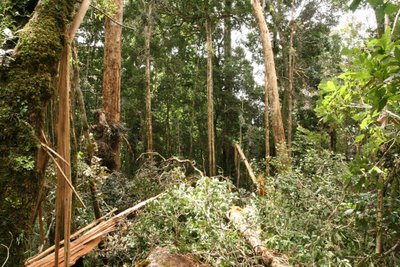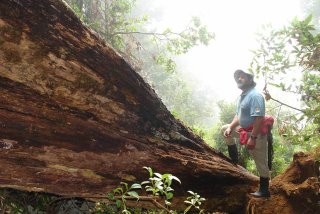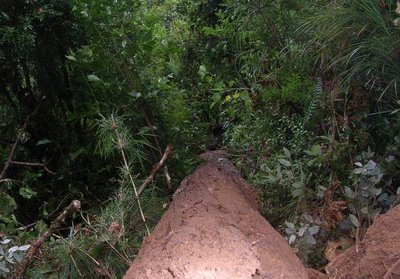Death of an Oak

Tree falls have significant impact on forest dynamics: returning nutrients to the soil, completely changing the light availability to the forest floor around them and wrecking havoc on the neighborhood of other trees and lower reaching plants. In the lower tropics, it takes an average of 137 years for the forest to refill the canopy gap left after the fall of a mature canopy tree. Here in the highlands of the Tamanaca, it’s likely to be much longer as these oaks may only grow ½ a meter in a decade.
Though you may be mighty, there are a number of ways to loose your life as a large canopy tree. On the other end of the spatial scale, you chief risk is micro and macro-organisms that will literally eat you from the inside out and outside in. Fires are extremely rare here but several have started in the last 100 years from neighboring farms and residents allow them to burn. The resulting fire damage can open a wound at your base allowing for disease and decomposition of your bark. Placement of your roots is critical, especially if your life began, ever so long ago, as a seed on a steep slope. In this circumstance, you will cling to the forest floor by the high anchor point of your root system and if something should compromise it, such as the root system of a neighboring tree, death is certain. The death of a neighbor also poses huge risk for when it falls, if it doesn’t take you out instantly, it can take off on of your branches, creating an opening for those that would feed themselves and all their progeny on your insides, all the way to your roots, eventually unearthing you too.
Most trees decompose through their core, usually because their core has been compromised. In this case, all that they were becomes food for the forest itself. If, however, a tree falls with its core in tact, especially in less moist microclimates, it will loose bark and cambium but retain that core for a very long time. We saw some trees in the forests of Cuerici that were almost shiny with wear and hard as rocks, fossilized where they fell.
I’ve teamed up with Laura Vary, a fantastic botanist, to look at tree falls and succession here in the cloud forest at Cueraci. The section we’re focusing on is dominated by a native bamboo, Chusquea, and two native species of oak, Quercus copeyensis & Q. costaricensis. Our aim is to describe a community succession pattern on a single species of oak based on age of the tree fall, light availability and health of the tree when it fell. Central to our study is the knowledge of our host here at Cueraci, Carlos Serano, whom we all call “Don Carlos”. Pictured below, he has helped us to find, age and diagnose a set of fallen oaks. From there, we catalog the set of plant (and possibly fungus) species present and look for patterns. Having no idea if any of this will amount to anything interesting, our day was nonetheless fascinating. Don Carlos shared his deep love and knowledge of the forest with us and showed us a monster tree fall: the death within the last 30 days of a thousand-year old giant. The fall of this single tree, pictured at the top of this post, took at least four others with it and left an enormous and precious light gap in the midst of otherwise tight canopy.

The next day we had an even more immediate experience of this phenomenon. Standing on the fallen now horizontal trunk of this enormous tree, we were stunned by a sudden cacophony of cracks, pops, followed by crashes and thunder from the ground. Over my left shoulder I glimpsed a large tree just beyond the clearing fall away to its death. I looked back at Laura as we both erupted with amazement. We waited 10 minutes and approached the scene tentatively in case the full domino effect of this newest tree fall had not yet played out. We arrived to find fresh dirt covering everything in proximity to the tree’s root system. Here’s a picture of the freshly fallen and the remnants of an unlucky neighbor.

Labels: Ecoinformatics, Healthy Planet


0 Comments:
Post a Comment Hide comments